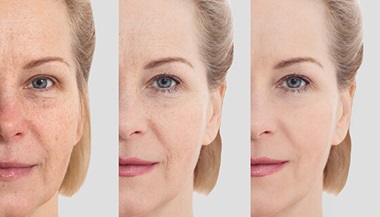Facelift
What is a facelift?
Rhytidectomy, a surgical procedure commonly known as a facelift, involves the removal of excess facial fat, the tightening of facial muscles, and the trimming or redraping of facial skin to approximate a smoother, firmer facial appearance. The procedure takes place on either the face, neck, or both.
Depending on the area of the face or neck where the "lift" is to take place, the surgeon will separate the skin from the underlying fat and muscle. The fat is then removed. Sutures are used to elevate the supporting fascial layers of the face and neck, and the skin is pulled back into place with any excess removed.
Facial Rejuvenation Surgery: 5 Things You Need to Know
A facelift is a procedure to lift and tighten sagging skin on the face and neck. A facelift provides longer-lasting and more dramatic results than other facial treatments. If you’re considering the procedure, here are five things to know.
Possible complications associated with facelifts
Possible complications associated with facelifts may include, but are not limited to, the following:
-
Nerve injury. Facial nerve injury or weakness may occur along with numbness or changes in skin sensation. This may be temporary or permanent.
-
Infection and anesthesia reaction. As with any type of surgery, there is a risk of infection and a reaction to the anesthesia.
-
Hematoma. A hematoma, blood that collects under the skin, could occur. They are generally removed by the doctor.
-
Slower healing process (for some people). Smokers, in particular, may find that the healing process following a facelift is slower than normal. Smoking in the period leading up to surgery, or after surgery, can contribute to skin injury and permanent scarring. Your surgeon may not perform your surgery if you are currently smoking.
-
Scarring. The scars may not heal properly and be more visible or thick than desired. This may require further treatment or revision.
Who are candidates for facelift?
The best candidates for a facelift are those whose face and/or neck have begun to sag, but whose skin still has some elasticity. The procedure also works best on persons whose bone structure is strong and well-defined.
About the procedure
Although each procedure varies, generally, facelift surgeries follow this process:
-
Location options may include:
-
Surgeon's office-based surgical facility
-
Outpatient surgery center
-
Hospital outpatient
-
Hospital inpatient
-
-
Anesthetic options may include:
-
General anesthesia
-
Local anesthesia, combined with intravenous sedation (allows the person to remain awake but sleepy and comfortable)
-
-
Average length of procedure:
-
Several hours or longer, if more than one procedure is being performed
-
-
Some possible short-term side effects of surgery:
-
Pain after surgery is not unusual, though generally well-controlled with medication
-
Temporary numbness of the skin
-
Achieving a Natural-Looking Facelift
Seminar Saving Face: Advice to Help Freshen Aging Skin

Age-related changes to the face don’t have to be noticeable. Learn about surgical and nonsurgical options to address signs of aging from Dr. Kofi Boahene.





